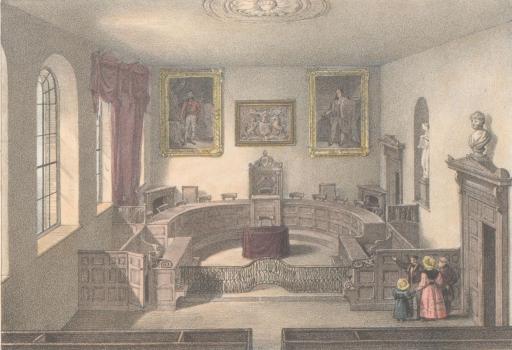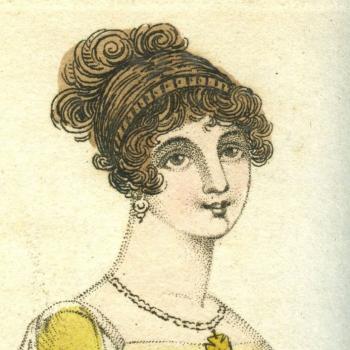11th May 2017
By Joseph-Laurent Couppey of Cherbourg, extract from 'Notice sur l'histoire des iles anglaises de Jersey, Guernesey et Aurigny, dans ses rapports avec l'histoire de la Normandie et spécialement du département de la Manche,' published in the Revue anglo-française, Poitiers, 1833, pp. 305-7. [From the French.]
10th May 2017
The Eclectic Review, Vol 17 (1), 1845, pp. 540-555. 1848 is the year of revolution in Europe; in Guernsey the stirrings of the people, such as they were, occurred just a few years earlier. (The headings have been added for ease of reading.) The illustration is a print from the Library Collection dated c 1835, published by M Moss, and showing the interior of the Royal Court in St Peter Port. 'May this people ever beware of apeing the follies of their neighbours, and retain their own dignified simplicity! For it they are pre-eminent. Should they ever stoop to become imitators, they can never get beyond an humble mimicry of that which is useless and effeminate in the customs of England.'
21st April 2017
On 5 March 1862 Hugo made arrangements with his cook, Marie Sixty, for a repas des enfants pauvres to be served every week, ‘the meal will be the same as ours, we shall serve them, they will say as they sit down Dieu soyez beni and on rising Dieu soyez remercié.’ [Carnet, Quatrième agenda, Massin p. 1387.] His son Charles disapproved of the wording (see letter from Hugo to Charles, Massin p. 1388, 22 March 1862). Hugo followed the teaching of a French doctor that meat and a glass of wine were good for growing children—not a medical opinion that would be advocated today. The first such lunch took place on 10 March 1862 and thereafter they were held on a regular basis. There was a special meal at Christmas, when presents were distributed. These were often of a useful nature—items of clothing for example, but there were also toys. This is part of The Victor Hugo and Guernsey project.
21st April 2017
In the early 1860s Hugo completed and revised his novel Les Misérables, a work that he had started in the 1840s. As he wrote about Cosette, Eponine, Fantine, Gavroche, Javert… he could not help but observe the poor, the suffering, and the wretched all around him in Guernsey. He had an active compassion and tried to help. Part of the Victor Hugo and Guernsey project.
19th April 2017
From the Gazette de Guernsey, January-September 1808, the spelling exactly as it was published. The 18th January was the occasion of a ball at the Assembly Rooms. The plate is dated October 1807 and is from the Library Collection.
12th April 2017
A lucky ticket, From the Gazette de Guernesey, 6 April 1822. A parody of a piece of puff for the Guernsey Lottery, the poem may be the work of Dr James Tupper - 'Monsieur Toupar' - who is known to have written light-hearted poems in Guernsey French.
10th February 2017
'Guernsey's unvisited valley, where a water mill is working.' From Victor Coysh's scrapbook, and probably written by him, 1931. The wheel was demolished during the Occupation, but has since been restored by the National Trust of Guernsey.
3rd February 2017
In a MSS book in the Library (Staff). 'Sir Stafford Carey's MSS. Taken by the Smiths and, after being kept in an barn, handed over by them to Wilfred Carey. March 1921.'
23rd January 2017
October 1820. From a commonplace book in the Library, Flowers, from the Garden of Imagination. The compiler of the book is unknown, but there is a cipher on the flyleaf that appears to read 'FDC.' Another poem, To a Lady, is dated 'Guildford, August 2, 1817,' and has the legend, 'On her Friend's leaving Guildford for Ireland, where she is soon to join her.'
20th January 2017
The Governor of Guernsey to Mr Carey, concerning Newfoundland. From Chefs Plaids &c p. 88.
19th January 2017
Daniel Girard, Castle Porter, that is, prison warden/jailkeeper, lost his prisoner, George Pellew, who had been committed to his care by Jean Dobrée. Pellew owed Dobrée money. The Royal Court, under the auspices of the Juge-Délegué, William Le Marchant, had ruled on 8 March 1719 that Daniel Girard should not be required in any way to compensate Dobrée. Dobrée appealed to the Privy Council, who requested a report on precedents to the Royal Court. The following letter is what the Royal Court produced in reply; on reading it, the Privy Councillors confirmed the Royal Court's initial judgment and dismissed the appeal.
5th December 2016
Guernsey centenarians before Mrs Neve.


